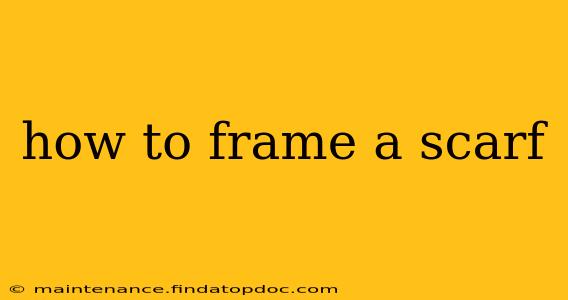Scarves, whether hand-knitted heirlooms, vibrant silk finds from travels abroad, or treasured gifts, often hold sentimental value far exceeding their monetary worth. Framing a scarf allows you to showcase its beauty while protecting it from damage, transforming a beloved accessory into a stunning piece of wall art. This guide will walk you through different framing techniques to help you preserve your cherished scarf.
What Type of Scarf Do You Have?
Before you begin, consider the material and size of your scarf. Different fabrics require different handling and framing methods. A delicate silk scarf needs gentler treatment than a thick, chunky knit. The size also influences your framing choices; a large scarf might require a custom frame or a more creative approach.
How to Choose the Right Frame and Matting
The frame and matting you select significantly impact the final presentation.
Frame Selection:
- Material: Wood frames offer a classic, elegant look and come in various finishes (e.g., natural wood, painted, stained). Metal frames provide a more modern or contemporary feel. Choose a frame material that complements your scarf's colours and style. Consider the weight of the scarf – heavier scarves might need a more robust frame.
- Size: Select a frame that's slightly larger than your scarf to allow for adequate matting and spacing. Avoid frames that are too large, as they can overwhelm the scarf.
- Style: The frame's style should complement the scarf's design. A simple, minimalist frame works well with bold, patterned scarves, while a more ornate frame might suit a delicate, intricate design.
Matting Considerations:
- Purpose: Matting provides a buffer between the scarf and the glass, protecting it from scratches and damage. It also adds visual appeal, creating a balanced composition.
- Colour: Choose a mat colour that complements the scarf's colours without overpowering it. Neutral colours like off-white, cream, or beige often work well. Consider colours that enhance specific shades in your scarf.
- Width: The width of the matting should be proportional to the scarf's size. Too much matting can look awkward, while too little might not provide enough protection.
Different Framing Methods for Scarves
Several methods effectively frame scarves, each offering unique advantages:
1. Traditional Frame with Matting:
This classic approach involves placing the scarf on a mat board, carefully centering it, and then securing it within a frame with glass or acrylic. This method is ideal for preserving the scarf's texture and colour. You may need to use acid-free matting and backing board to prevent damage over time.
2. Shadow Box Framing:
A shadow box frame offers three-dimensional display and is perfect for showcasing textured scarves. It provides more depth and allows you to incorporate other elements, like buttons or embellishments from the scarf's construction.
3. Layered Framing:
For extra large scarves or those with particularly delicate fabrics, layering can be employed. This might involve using multiple layers of acid-free backing and carefully arranging the scarf to create visual interest.
Preparing Your Scarf for Framing
Before you begin framing, ensure your scarf is clean and free of wrinkles. Gently press it with a warm iron (using a pressing cloth appropriate for the fabric type) to minimize creases. Avoid using excessive heat, which could damage delicate materials.
Addressing Frequently Asked Questions
How do I prevent my framed scarf from fading?
Use UV-protective glass or acrylic to minimize fading from sunlight. Keep the framed scarf away from direct sunlight to further protect its colour and vibrancy.
What is the best way to secure a scarf in a frame without damaging it?
Acid-free archival tape or delicate pins are recommended for securing the scarf. Avoid using staples or adhesives that could leave residue or damage the fabric.
Can I frame a very large scarf?
Larger scarves might require custom framing or a creative approach, such as dividing the scarf and framing sections individually, perhaps incorporating decorative stitching to connect the framed parts.
What type of glass should I use for framing a scarf?
UV-protective glass or acrylic is best to prevent fading.
How much does it cost to professionally frame a scarf?
The cost varies depending on frame size, materials, and the framing shop's pricing. It’s best to contact local framers for accurate quotes.
Framing a scarf is a rewarding project that allows you to transform a cherished item into a lasting piece of art. By carefully selecting the right materials and employing the appropriate techniques, you can preserve your scarf’s beauty and sentimental value for generations to come. Remember to consult a professional framer if you are unsure about any aspect of the process.
